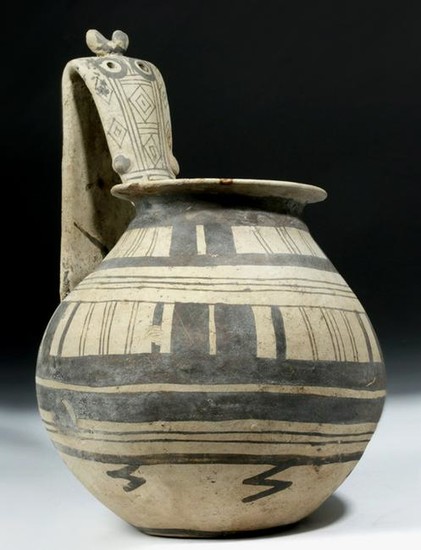Greek Daunian Pottery Kyathos - Bat Head
**Originally Listed At $1200**
Greek South Italic Colonies, Italy, Daunia, ca. 300 BCE. A tall, round vessel with a bat finial on its large handle and a wide, flat rim. Daunian society was a mixture of native Italians and Greeks who had settled in the area. The shapes of the vessels remained strongly influenced by the Italians - this one, for example, is a form of the Greek kyathos, or dipper, with a flat, long handle that folds over sharply at the top, but the width of the strap is purely Daunian in style. Many of these vessels, like this one, were ornamented with bands of geometric decoration called listati. Here they are rendered in black on buff ceramic, with wide bands of lines everywhere but the final ring around the lower part of the body, which has repeated, widely-spaced lightning-strike motifs. The strap has repeated diamond-shaped motifs and the bat finial is comprised of two large ears and a short nose above two drilled holes that seem to represent the two breasts of the bat. Size: 7.4" W x 10.75" H (18.8 cm x 27.3 cm)
Bat symbolism in the Classical World is fascinating. The ancients would have compared them in some regards to human women, because of their two breasts and the fact that they give birth to only one or, occasionally, two offspring at a time. Bats also, as in many cultures, were associated with the underworld and death, presumably because of their nocturnal habits and fondness for dark places like cave ceilings. Bats were sacred to Persephone, wife of Hades, and goddess of the underworld. Homer describes the souls of the dead: "Just as inside the corners of a monstrous cave/ bats flit around and squeak when one of them falls down/ out of the cluster on the rock where they cling/ to one another, that is how these spirits squawked as they moved on together." As this vessel was almost certainly made to grace a tomb, the bat symbolism complements its function.
Provenance: private Swiss collection
All items legal to buy/sell under U.S. Statute covering cultural patrimony Code 2600, CHAPTER 14, and are guaranteed to be as described or your money back.
A Certificate of Authenticity will accompany all winning bids.
We ship worldwide to most countries and handle all shipping in-house for your convenience.
#124244
Condition Report: Repaired from multiple pieces, with some restoration/repainting on the handle. Small area of staining/damage on rim as shown. Excellent remaining pigment.
View it on
Estimate
Time, Location
Auction House
**Originally Listed At $1200**
Greek South Italic Colonies, Italy, Daunia, ca. 300 BCE. A tall, round vessel with a bat finial on its large handle and a wide, flat rim. Daunian society was a mixture of native Italians and Greeks who had settled in the area. The shapes of the vessels remained strongly influenced by the Italians - this one, for example, is a form of the Greek kyathos, or dipper, with a flat, long handle that folds over sharply at the top, but the width of the strap is purely Daunian in style. Many of these vessels, like this one, were ornamented with bands of geometric decoration called listati. Here they are rendered in black on buff ceramic, with wide bands of lines everywhere but the final ring around the lower part of the body, which has repeated, widely-spaced lightning-strike motifs. The strap has repeated diamond-shaped motifs and the bat finial is comprised of two large ears and a short nose above two drilled holes that seem to represent the two breasts of the bat. Size: 7.4" W x 10.75" H (18.8 cm x 27.3 cm)
Bat symbolism in the Classical World is fascinating. The ancients would have compared them in some regards to human women, because of their two breasts and the fact that they give birth to only one or, occasionally, two offspring at a time. Bats also, as in many cultures, were associated with the underworld and death, presumably because of their nocturnal habits and fondness for dark places like cave ceilings. Bats were sacred to Persephone, wife of Hades, and goddess of the underworld. Homer describes the souls of the dead: "Just as inside the corners of a monstrous cave/ bats flit around and squeak when one of them falls down/ out of the cluster on the rock where they cling/ to one another, that is how these spirits squawked as they moved on together." As this vessel was almost certainly made to grace a tomb, the bat symbolism complements its function.
Provenance: private Swiss collection
All items legal to buy/sell under U.S. Statute covering cultural patrimony Code 2600, CHAPTER 14, and are guaranteed to be as described or your money back.
A Certificate of Authenticity will accompany all winning bids.
We ship worldwide to most countries and handle all shipping in-house for your convenience.
#124244
Condition Report: Repaired from multiple pieces, with some restoration/repainting on the handle. Small area of staining/damage on rim as shown. Excellent remaining pigment.



